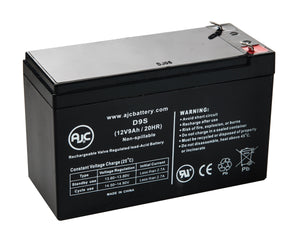AGM Batteries: Pros and Cons
As we learned in Types of Lead Acid Batteries, Absorbed Glass Mat (AGM) batteries, initially engineered for demanding military applications, gained widespread adoption in the commercial sector starting in the 1980s. Their superior performance characteristics made them ideal for critical systems such as military aircraft, robust heavy-duty vehicles, and Uninterruptible Power Supplies (UPS), among a growing list of other uses. Compared to traditional flooded lead-acid batteries, AGMs offer significant advantages, including a lighter weight, enhanced reliability under stress, and the ability to endure more punishing operational conditions.
The core innovation in an AGM battery lies in its construction. Instead of the electrolyte existing as a free-flowing liquid that floods the lead plates, it is absorbed and held in close contact with the plates by thin, highly porous fiberglass mats. This unique design provides several key benefits over conventional, flooded Sealed Lead Acid (SLA) batteries.

In an AGM battery, the electrolyte is held next to the plates in thin fiberglass mats, instead of freely flooding the plates. This construction gives them some advantages over traditional, flooded, Sealed Lead Acid batteries.
Pros for AGM Batteries
- Completely Spill-Proof Design: Due to the electrolyte being contained within the fiberglass mats, AGM batteries are inherently spill-proof. This means that even if the battery casing is cracked or broken, the acid will not leak out. This feature not only enhances safety during use and handling but also makes them safe for transportation, often exempting them from stringent hazardous materials regulations that apply to flooded batteries.
- Exceptional Vibration Resistance: Originally conceived for the rigorous environments of military airplanes and helicopters, AGM batteries possess outstanding resistance to constant and intense vibrations. This robust construction ensures reliable performance in applications where significant vibration is unavoidable, such as off-road vehicles, marine vessels operating in choppy waters, and heavy machinery.
- Superior Shock Resistance: Similar to their resistance to vibration, the tightly packed internal components of AGM batteries make them highly resistant to physical shocks and impacts. This durability is crucial in applications where the battery might experience rough handling or sudden jolts.
- Enhanced Performance in Colder Temperatures: AGM batteries exhibit better performance in cold climates compared to traditional wet cell batteries. While extreme cold can still impact their overall power output temporarily, they are less susceptible to freezing. Remarkably, even if an AGM battery does freeze, its internal structure is less likely to suffer permanent damage, although it will not function until thawed.
- Flexible Installation in Any Orientation: The spill-proof nature of AGM batteries allows for installation in virtually any physical orientation – upright, sideways, or even upside down – without the risk of leakage. This flexibility provides greater design freedom for equipment manufacturers and simplifies installation in tight or unconventional spaces.
- Minimal Gassing for Safer Operation: During charging and discharging, AGM batteries produce very little gas compared to flooded batteries. This minimal gassing makes them suitable for use in less well-ventilated areas or within enclosed equipment compartments where the buildup of corrosive or flammable gases could be a concern.
- Low Self-Discharge Rate for Extended Storage: AGM batteries have a significantly lower self-discharge rate than flooded batteries. This means they can retain their charge for longer periods when not in use, making them ideal for seasonal equipment or backup power systems that may 1 sit idle for extended durations without requiring frequent recharging.
- Extended Lifespan with Proper Care: When maintained correctly, AGM batteries often outlast traditional SLA batteries. Their robust construction and resistance to common failure modes contribute to their longevity, providing a better return on investment over time.
- Truly Maintenance-Free Operation: Unlike flooded batteries that require periodic checks and topping off of electrolyte levels, AGM batteries are completely sealed and require no routine maintenance. This convenience saves time and effort for the user.
These highly dependable batteries find widespread use in a variety of demanding applications, including marine vehicles, recreational vehicles (RVs), golf carts, wheelchairs and mobility scooters, Uninterruptible Power Supply (UPS) systems for critical electronics, and high-end motorcycles where durability is paramount or where the battery's orientation is a design constraint.
Cons for AGM Batteries
- Higher Initial Manufacturing Costs: The advanced materials and construction techniques involved in manufacturing AGM batteries result in higher production costs, which translates to a more expensive purchase price compared to traditional flooded batteries.
- Sensitivity to Overcharging and Specific Charging Requirements: AGM batteries are more sensitive to overcharging and excessively high voltages. Overcharging can lead to premature failure. Furthermore, they generally require a full charge between uses to maintain optimal performance, which might not be practical in all applications where frequent, short discharges occur without the opportunity for a complete recharge.
- Need for Specialized AGM Battery Chargers: To ensure proper charging and prevent damage, AGM batteries typically require a battery charger specifically designed for their unique charging profile. These chargers often incorporate sophisticated monitoring of voltage, current (amps), and even ambient temperature to optimize the charging process. Using a standard charger designed for flooded batteries can lead to undercharging or overcharging, both of which can negatively impact the AGM battery's lifespan and performance.
- Potential Inaccuracy with Older Battery Testers: Some older or less sophisticated battery testers that rely on specific gravity measurements are not suitable for accurately testing AGM batteries due to their sealed design and the way the electrolyte is contained. Proper testing often requires more advanced conductance or impedance testers.
Overall, AGM batteries represent a significant advancement in lead-acid battery technology. Their well-engineered design, inherent reliability, and exceptional durability make them a preferred power source for a wide range of applications where their numerous advantages clearly outweigh their specific disadvantages, particularly in demanding environments and critical systems.
Find Your Replacement Battery
Browse our website to see if we have a match for your replacement battery
Browse Batteries

